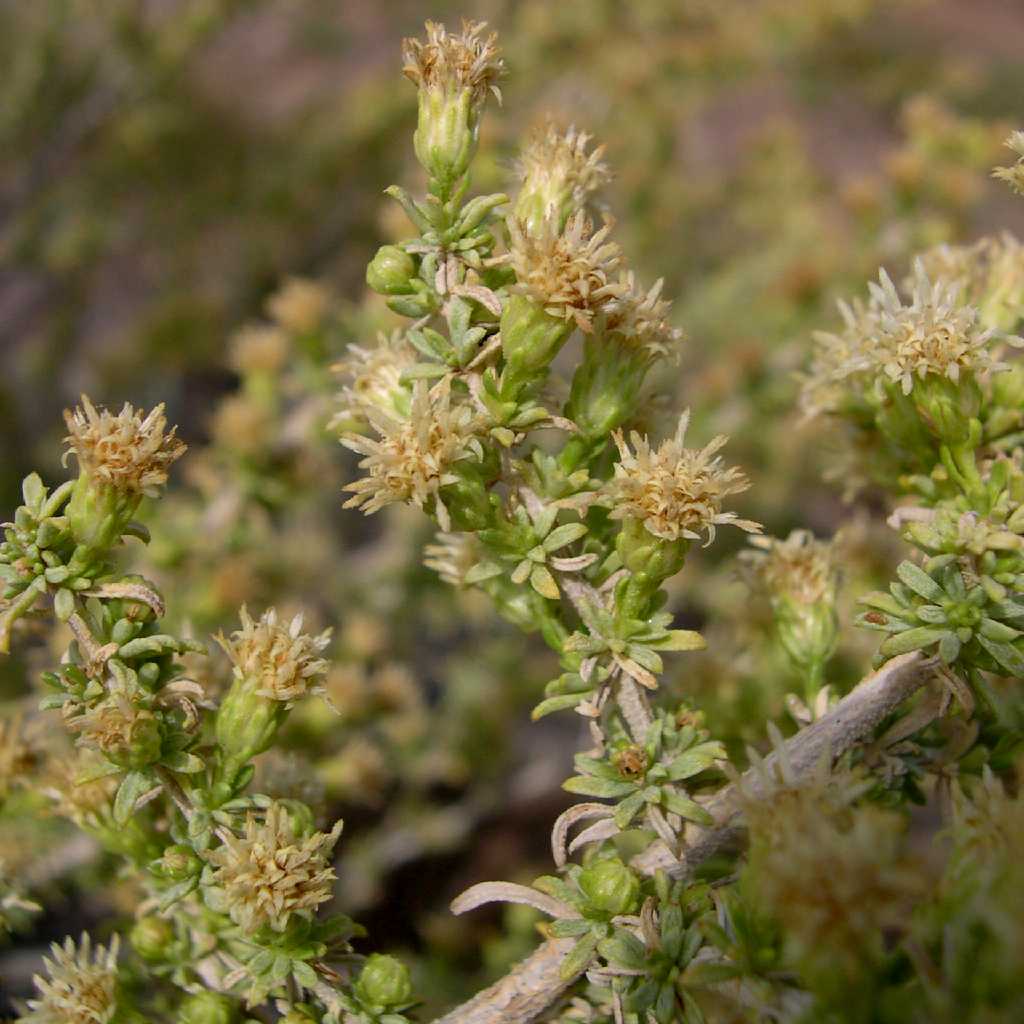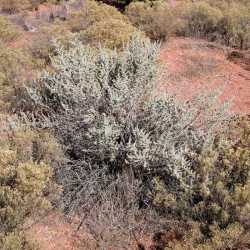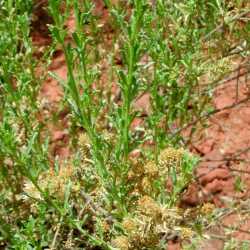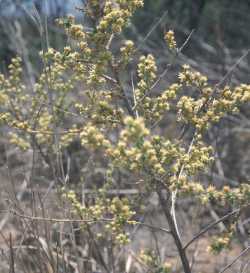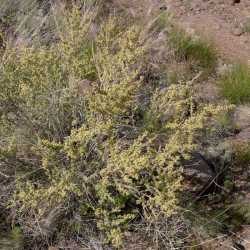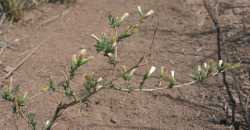|
|
|
|
Family: Asteraceae
yerba de pasmo
|
Shrubs, 30-100 cm (diffusely and evenly branched with thick woody crowns). Stems erect, terete, brittle, slightly striate, scabrous, stipitate-glandular, papillose-roughened. Leaves cauline (proximal withering before flowering, distal crowded in gascicles); sessile; blades linear to lanceolate or spatulate, 5-25 × 1-6 mm (stiff, coriaceous to fleshy) , bases attenuate, margins sharply serrate (teeth 1-5 pairs, distal leaves often entire), faces glabrous, gland-dotted, resinous. Heads (10-20+ on densely leafy lateral branchlets) in spreading racemiform arrays. Involucres campanulate; staminate 4-5 mm, pistillate 5-6(-7) mm. Phyllaries ovate to lanceolate, 1-5 mm, margins scarious, medians green, apices acute to acuminate, glabrous. Staminate florets 15-20; corollas 4-5 mm. Pistillate florets 15-20; corollas 4-5 mm. Cypselae 1.8-3 mm, 8-10-nerved, minutely papillose-glandular; pappi 8-10 mm (bristles rigid). Flowering Apr-Jun. Dry canyons, roadsides, open oak woodlands, grasslands; 300-2000 m; Ariz., N.Mex., Tex.; Mexico. Baccharis pteronioides is characterized by its shrubby stiff habit, rough gray bark, branches that are evenly spaced and often at 45° angles, fascicles of narrow sessile leaves, and heads in racemiform arrays on short leafy branches. The Mexican common name yerba de pasmo refers to an infusion of the leaves used to treat chills (pasmo) and sores; the plants are also said to be poisonous to cattle and sheep.
FNA 2006, Benson and Darrow 1981, Kearney and Peebles 1969 Common Name: yerba de pasmo Duration: Perennial Nativity: Native Lifeform: Shrub General: Low, diffusely branched shrub, 30-100 cm tall; stems erect, brittle, slightly striate, scabrous. Leaves: Alternate and sessile, the proximal leaves withering before the plant flowers; blades linear, lanceolate, or spatulate, with attenuate bases, 5-25 mm long by 1-6 mm wide, the texture leathery to fleshy, surfaces glabrous and resinous, margins sharply serrate with 1-5 pairs of teeth, distal leaves often entire. Flowers: Flower heads unisexual, discoid, arranged in racemes; involucre (the ring of bracts surrounding the flower head) bell-shaped, 4-6 mm high, the bracts (phyllaries) ovate to lanceolate, 1-5 mm, green in the middle, with scarious margins and acute to acuminate apices; corollas 4-5 mm, white (pistillate) to yellowish (staminate). Fruits: Achenes 2-3 mm, 8-10 nerved, minutely papillose-glandular, with a pappus of bristles, 8-10 mm, white, lustrous, and abundant. Ecology: Found on dry roadsides, in grasslands, and in open oak woodlands from 3,500-6,000 ft (1067-1829 m); flowers April-June. Distribution: AZ, NM, sw TX; south to s MEX. Notes: Baccharis is a genus of dioecious shrubs with gland-dotted leaves, all disc flowers, and a pappus of bristles. This species is distinguished by rough gray bark; clumps of sticky-glandular, toothed leaves at the nodes; young branches which are green, sticky and with leaves larger and more developed than older stems; and flower heads on the ends of short, leafy branches, the inflorescence leaves minute and entire. Ethnobotany: Roots and leaves used as an antirheumatic and as a wash for venereal diseases. Etymology: Baccharis is named for Bacchus, the god of wine, while pteronioides comes from Greek pteros, a wing, and oeides, resembling or having the form of. Synonyms: None Editor: SBuckley 2010, FSCoburn 2015, AHazelton 2015 |


